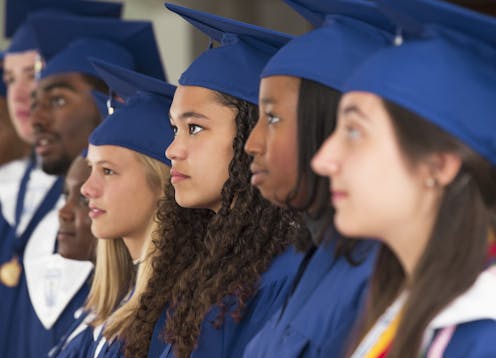Federal Pell Grants help pay for college – but are they enough to help students finish?
New research shows that low-income students who qualify for the federal Pell Grant tend to go to non-selective colleges – and why that hurts their chances of graduation.

Pell Grants are one way the federal government helps people pay for college.
During the 2020 to 2021 school year, eligible students can receive up to US$6,345 through the program, depending on where they go to school, how many classes they take and how much money their family makes.
Despite this assistance, students who receive Pell Grants are less likely than other students to graduate from a four-year institution within six years: 51% versus 59% for students who first enrolled in 2010. Six years is the timespan the federal government uses to measure graduation rates.
One reason for this disparity is that Pell Grant recipients tend to go to less selective colleges and universities. Graduation rates are lower for these institutions than for more selective institutions.
For instance, at four-year colleges with open admissions – that is, an institution where just about anyone who applies gets in – only 31% of students who first enrolled full-time in 2011 graduated within six years. At selective schools, which admit only a quarter of their applicants, 87% did.
We are scholars who study why students attend different colleges and other issues of fairness in higher education. One of our recent studies finds that institutions that enroll high numbers of Pell grant recipients also have other characteristics that are linked with lower graduation rates, such as having fewer students live on campus and spending less per student on instruction.
Our findings have implications for policymakers, taxpayers, college leaders and Pell Grant students themselves.
College choice
About a third of the nation’s approximately 22 million college students received these grants in 2018. The federal government spent about $28 billion on Pell Grants in that school year.
More than half, 58%, of Pell Grant recipients who are financially dependent on their parents had family incomes below $30,000 in 2015-16.
But not all Pell Grant recipients are young or live with their parents. About half (53%) take care of themselves and 42% were age 24 or older.
More degrees
Congress first created what is now known as the Federal Pell Grant program in 1972. A primary goal was to address financial barriers to college enrollment for students from low-income families.
Even with the availability of the federal Pell Grant, college enrollment rates continue to be lower for students from lower-income families.
And, simply enrolling in college isn’t enough to lift these students out of poverty. They need to graduate. Georgetown University’s Center on Education and the Workforce has found that increasingly, “good jobs” – defined as a job “that pays at least $35,000 for workers 25 to 44 and at least $45,000 for workers 45 to 64” – require at least a bachelor’s degree.
Structural barriers
In a report we produced with The Pell Institute, a research and policy analysis organization that focuses on low-income, first-generation and disabled students, we found that, at community colleges, 55% of first-year, full-time students got federal grants, including Pell Grants, in 2016-17.

The percentage was even higher at for-profit colleges – 68%.
In contrast, at the nation’s most academically selective colleges, only 16% of first-time, full-time students received federal grants.
One reason Pell Grant recipients more commonly attend open-enrollment and less selective colleges is that students from low-income families more often attend K-12 schools with fewer academically demanding courses. Lack of academic preparation reduces their chances of getting into a competitive college. And it contributes to the need to take developmental or remedial education courses.
A 2015 report published by The Education Trust shows that graduation rates are higher for Pell recipients at more academically selective institutions. At institutions enrolling students with the highest SAT scores, graduation rates were 74% for Pell recipients and 79% for non-Pell recipients. At institutions enrolling students with the lowest SAT scores, graduation rates averaged 37% for Pell recipients and 42% for non-Pell recipients.
Lower-income students who attend the most selective schools also fare as well as their affluent peers in terms of how much money they make after college, according to Opportunity Insights, a Harvard University-based research and policy analysis group.
Supporting low-income students
Much attention has focused on increasing enrollment of Pell recipients in the nation’s most selective institutions. While important, we believe these efforts are not enough.
Much more must be done to improve graduation rates at the open-access and less selective colleges in which many more of the nation’s Pell recipients enroll. In fall 2015, just 8% of all undergraduates were attending the nation’s most and highly selective colleges and universities. By comparison, 37% of all undergraduates were enrolled in community colleges and other two-year colleges.
[You’re smart and curious about the world. So are The Conversation’s authors and editors. You can read us daily by subscribing to our newsletter.]
Some of the data and research in this article was generated with a support from a grant from Lumina Foundation. The findings and opinions are those of the authors and may not reflect the views of the funder.
Jeremy Wright-Kim does not work for, consult, own shares in or receive funding from any company or organisation that would benefit from this article, and has disclosed no relevant affiliations beyond their academic appointment.
Read These Next
New materials, old physics – the science behind how your winter jacket keeps you warm
Winter jackets may seem simple, but sophisticated engineering allows them to keep body heat locked in,…
West Antarctica’s history of rapid melting foretells sudden shifts in continent’s ‘catastrophic’ geo
A picture of what West Antarctica looked like when its ice sheet melted in the past can offer insight…
The celibate, dancing Shakers were once seen as a threat to society – 250 years later, they’re part
‘The Testament of Ann Lee,’ Mona Fastvold’s 2025 film, depicts part of the long history of Shaker…






